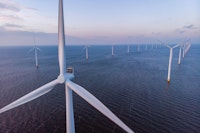The licensing process for onshore wind power is resumed and the development of a regulatory framework for offshore wind continues.
On Friday 8 April 2022, the Government published its supplementary paper to the previous government's white paper from June 2021. In the paper, available here (Norwegian version), the Government sets out its ambitions for the energy sector in the years to come.
In light of the recent geopolitical situation, which has put a intensified focus on renewable energy production, certain expectations related to concrete measures were anticipated from the Government.
Measures related to wind power
Related to wind power, the Government presented the following measures:
The licensing process for onshore wind power is resumed
After the licensing process for onshore wind was temporary stopped in April 2019, the developers have had to choke back new projects. In June 2021, the processing of existing applications was resumed, provided the host municipality requested it. The Government is now asking the Norwegian Water Resources and Energy Directorate (NVE) to resume processing of also new wind power projects where the host municipality consents. This means that if local conditions facilitate it, the developers can take the project work one step further. Unsurprisingly, it is specifically pointed out in the supplementary paper that Sami interests must be safeguarded in all stages of the licensing process.
The Ministry's instructions to the NVE are that the processing of new license applications must be based on "the changes and considerations that follow from the wind power report (Meld. St. 28 (2019-2020)) and the Parliament's processing of this, and which can be carried out without changes in legislation and other regulations". These elements are further elaborated in the letter, which can be read in full here (Norwegian version). As expected, the NVE is requested to apply clear requirements for a participation process, stipulate clear licensing conditions and assess socio-economic profitability, where advantages and disadvantages are made visible and weighed against each other.
Further, the Government announces that it will follow up the decisions made by the Parliament in 2020 with the publication of the white paper on onshore wind power (Meld. St. 28 (2019-2020)). The Government intends, inter alia, to during the summer of 2022 submit for public consultation the necessary legislative amendments to include planning and construction of onshore wind farms in the Planning and Building Act. The specific role of the municipalities in the licensing process for onshore wind projects will probably not be clarified until these legislative amendments are in place.
The Government is also following up the consultation round on production tax for wind power. It is intended that the tax can be introduced this year. The final design of changes in the tax for wind power will be presented in the state budget for 2023.
The Government intends to make the licensing process for offshore wind more efficient
The supplementary paper contains relatively limited news for those who are particularly interested in offshore wind. However, the Government clearly communicates that it will look at the possibilities of implementing a more efficient licensing process to reduce the time before the first turbines can produce power for the market. The Government aims for the first projects to be ready for operation prior to 2030. One such proposed efficiency measure is a proposal for additional funding in connection with the revised state budget, so that preparatory studies of the opened areas can be initiated.
With regard to feedback from the developers that hybrid projects are a prerequisite for profitable projects, it is briefly pointed out that this is something that is currently under consideration. The first production area of 1,500 MW in Sørlige Nordsjø II will be connected through a production radial to the mainland in Norway, while the infrastructural design for the next 1,500 MW will be decided later when the report on hybrid grid has been completed and assessed.
For the developers, it is worth noting that the Government has included a summary of what the Ministry of Petroleum and Energy considers to be the most important parts of the further process based on previous consultation responses. The Ministry stipulates that:
- Developers in consortium may collectively meet the requirements for pre-qualification. Experience and competence from the developers' group/parent companies will be considered relevant.
- The pre-qualification requirements may vary from area to area, and will be submitted for public consultation before being finally determined.
- The need for clarifications on the organization and development of grid infrastructure before allocating areas is recognized.
- Qualitative criteria should be flexible and will therefore be submitted for public consultation in connection with the announcement of each relevant area.
- Statnett (the Norwegian TSO) is assigned the responsibility for planning the offshore grid in accordance with the guidelines given by the Ministry. Statnett will also be involved in any hybrid project.
The supplementary paper also confirms that qualitative criteria will be introduced for the allocation of areas on Utsira Nord. The criteria will be focused around industrial development, innovation and technology development within floating offshore wind. Concerning Sørlige Nordsjø II, the Government confirms that the areas will be allocated through auction. The Government aims for the auction model to be completed during 2022. The specific qualitative criteria, as well as the assessments of a potential state aid scheme for floating offshore wind on Utsira Nord, will be prepared in parallel.
The Government announces that an amendment to the Offshore Energy Act will be promoted shortly, and other frameworks for allocating areas will be established, in line with the proposals that have been consulted so far. Specific pre-qualification criteria, auction model and qualitative criteria will be submitted for public consultation prior to the announcement of areas.
Our assessment
As expected, it will still take time before the framework conditions for large-scale offshore wind developments on the Norwegian continental shelf are clarified. We note that those hoping for a concrete level of ambition from the Government, still have to wait patiently. However, it is pleasant to see that the authorities have included the input in connection with streamlining the licensing process, so that it can still be realistic to realize offshore wind projects before 2030.
Please also view our webinar (in Norwegian only) from November 2021where we emphasized the importance of parallel processes as a measure to realize offshore wind projects efficiently.
Whether the announcement related to the processing of new projects on land will lead to new momentum amongst developers remains to be seen. Benevolent host municipalities will be a prerequisite. However, the final picture will only become clear when the notified changes in the Planning and Building Act are determined.
It is otherwise worth noting that the Government highlights electrification projects on the continental shelf as an important climate measure. In the same breath, the Government points out that large-scale development of offshore wind and thus power production on the continental shelf will be facilitated, which will contribute to the investment in electrification both on the shelf and onshore. With the current progress in offshore wind in general, at the same time as concrete plans for offshore wind turbines associated with petroleum installations (for example the Brage and Ekofisk fields in addition to Hywind Tampen), it may seem that Hywind Tampen's recipe will still be the fastest way to realize offshore wind projects.



